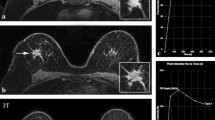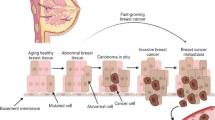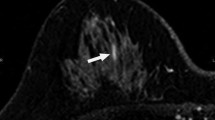Abstract
Objective
To identify which breast lesion descriptors in the ACR BI-RADS® MRI lexicon are most strongly associated with the diagnosis of breast cancer when performing breast MR imaging at 3 T.
Methods
150 patients underwent breast MR imaging at 3 T. Lesion size, morphology and enhancement kinetics were assessed according to the BI-RADS® classification. Sensitivity, specificity and diagnostic accuracy were assessed. The effects of the BI-RADS® descriptors on sensitivity and specificity were evaluated. Data were analysed using logistic regression. Histopathological diagnoses were used as the standard of reference.
Results
The sensitivity, specificity and diagnostic accuracy of breast MRI at 3 T was 99%, 81% and 93%, respectively. In univariate analysis, the final diagnosis of malignancy was positively associated with irregular shape (p < 0.001), irregular margin (p < 0.001), heterogeneous enhancement (p < 0.001), Type 3 enhancement kinetics (p = 0.02), increasing patient age (p = 0.02) and larger lesion size (p < 0.001). In multivariate analysis, significant associations with malignancy remained for mass shape (p = 0.06), mass margin (p < 0.001), internal enhancement pattern (p = 0.03) and Type 3 enhancement kinetics (p = 0.06).
Conclusion
The ACR BI-RADS® breast lesion descriptors that are mostly strongly associated with breast cancer in breast MR imaging at 3 T are lesion shape, lesion margin, internal enhancement pattern and Type 3 enhancement kinetics.
Key Points
• 3 Tesla breast MRI allows an accurate diagnosis of breast cancer
• The BI-RADS® descriptors help provide a confident diagnosis
• The shape, margin, enhancement pattern and kinetics are the most important features
• An irregular shape and margin, heterogeneous enhancement and type-3 kinetics indicate malignancy


Similar content being viewed by others
References
Helbich TH (2000) Contrast-enhanced magnetic resonance imaging of the breast. Eur J Radiol 34(3):208–219
Kuhl C (2007) The current status of breast MR imaging - Part I. Choice of technique, image interpretation, diagnostic accuracy, and transfer to clinical practice. Radiology 244(2):356–378
Kuhl CK (2007) Current status of breast MR imaging. Part 2. Clinical applications. Radiology 244(3):672–691
Kinkel K, Helbich TH, Esserman LJ et al (2000) Dynamic high-spatial-resolution MR imaging of suspicious breast lesions: diagnostic criteria and interobserver variability. AJR Am J Roentgenol 175(1):35–43
Liberman L, Morris EA, Lee MJ et al (2002) Breast lesions detected on MR imaging: features and positive predictive value. AJR Am J Roentgenol 179(1):171–178
Vomweg TW, Teifke A, Schreiber WG, Schmidt M, Thelen M (2002) Combination of low and high resolution T1-weighted sequences for improved evaluation of morphologic criteria in dynamic contrast enhanced MRI of the breast. Rofo 174(11):1445–1449
Pinker K, Grabner G, Bogner W et al (2009) A combined high temporal and high spatial resolution 3 Tesla MR imaging protocol for the assessment of breast lesions: initial results. Invest Radiol 44(9):553–558
Kuhl CK, Jost P, Morakkabati N, Zivanovic O, Schild HH, Gieseke J (2006) Contrast-enhanced MR imaging of the breast at 3.0 and 1.5 T in the same patients: initial experience. Radiology 239(3):666–676
Kuhl CK (2007) Breast MR imaging at 3T. Magn Reson Imaging Clin N Am 15(3):315–320, vi
Noebauer-Huhmann IM, Pinker K, Barth M et al (2006) Contrast-enhanced, high-resolution, susceptibility-weighted magnetic resonance imaging of the brain: dose-dependent optimization at 3 tesla and 1.5 tesla in healthy volunteers. Invest Radiol 41(3):249–255
Pinker K, Ba-Ssalamah A, Wolfsberger S, Mlynarik V, Knosp E, Trattnig S (2005) The value of high-field MRI (3 T) in the assessment of sellar lesions. Eur J Radiol 54(3):327–334
Ba-Ssalamah A, Nobauer-Huhmann IM, Pinker K et al (2003) Effect of contrast dose and field strength in the magnetic resonance detection of brain metastases. Invest Radiol 38(7):415–422
Schmitz AC, Peters NH, Veldhuis WB et al (2008) Contrast-enhanced 3.0-T breast MRI for characterization of breast lesions: increased specificity by using vascular maps. Eur Radiol 18(2):355–364
Mann RM, Kuhl CK, Kinkel K, Boetes C (2008) Breast MRI: guidelines from the European Society of Breast Imaging. Eur Radiol 18(7):1307–1318
Elsamaloty H, Elzawawi MS, Mohammad S, Herial N (2009) Increasing accuracy of detection of breast cancer with 3-T MRI. AJR Am J Roentgenol 192(4):1142–1148
Radiology RVACo (2003) American College of Radiology (ACR). Breast Imaging and Reporting Data System (BI-RADS). (4th ed.)
Demartini WB, Kurland BF, Gutierrez RL, Blackmore CC, Peacock S, Lehman CD (2011) Probability of malignancy for lesions detected on breast MRI: a predictive model incorporating BI-RADS imaging features and patient characteristics. Eur Radiol 21(8):1609–1617
Gutierrez RL, DeMartini WB, Eby PR, Kurland BF, Peacock S, Lehman CD (2009) BI-RADS lesion characteristics predict likelihood of malignancy in breast MRI for masses but not for nonmasslike enhancement. AJR Am J Roentgenol 193(4):994–1000
Schnall MD, Blume J, Bluemke DA et al (2006) Diagnostic architectural and dynamic features at breast MR imaging: multicenter study. Radiology 238(1):42–53
Collins DHC, Peters TM, Evans AC (1995) Automatic 3-D model-based neuroanatomical segmentation. Hum Brain Mapp 3(3):190–208
Morris EA (2001) Illustrated breast MR lexicon. Semin Roentgenol 36(3):238–249
Morris EA (2001) Review of breast MRI: indications and limitations. Semin Roentgenol 36(3):226–237
Kuhl CK, Mielcareck P, Klaschik S et al (1999) Dynamic breast MR imaging: are signal intensity time course data useful for differential diagnosis of enhancing lesions? Radiology 211(1):101–110
Nunes LW, Schnall MD, Orel SG (2001) Update of breast MR imaging architectural interpretation model. Radiology 219(2):484–494
Nunes LW, Schnall MD, Orel SG et al (1997) Breast MR imaging: interpretation model. Radiology 202(3):833–841
Kuhl CK, Schild HH, Morakkabati N (2005) Dynamic bilateral contrast-enhanced MR imaging of the breast: trade-off between spatial and temporal resolution. Radiology 236(3):789–800
Agrawal G, Su MY, Nalcioglu O, Feig SA, Chen JH (2009) Significance of breast lesion descriptors in the ACR BI-RADS MRI lexicon. Cancer 115(7):1363–1380
Tardivon AA, Athanasiou A, Thibault F, El Khoury C (2007) Breast imaging and reporting data system (BI-RADS): magnetic resonance imaging. Eur J Radiol 61(2):212–215
Floery D, Helbich TH (2006) MRI-Guided percutaneous biopsy of breast lesions: materials, techniques, success rates, and management in patients with suspected radiologic-pathologic mismatch. Magn Reson Imaging Clin N Am 14(3):411–425, viii
Schueller G, Jaromi S, Ponhold L et al (2008) US-guided 14-gauge core-needle breast biopsy: results of a validation study in 1352 cases. Radiology 248(2):406–413
Kluttig A, Trocchi P, Heinig A et al (2007) Reliability and validity of needle biopsy evaluation of breast-abnormalities using the B-categorization–design and objectives of the Diagnosis Optimisation Study (DIOS). BMC Cancer 7:100
Pathologists RCo (2001) NHS Cancer Screening Programes: Guidelinesfor non-operative diagnostic procedures and reporting in breast cancer screening(ed)^(eds). NSHBSP publication, Sheffield
Pathology EWGoBS (2006) Quality assurance guidelines for pathologyEuropean guidelines for quality assurance in cancer screening and diagnosis, 4th edn. European Union, pp 219–312
Gutierrez RL, Demartini WB, Eby P, Kurland BF, Peacock S, Lehman CD (2009) Clinical indication and patient age predict likelihood of malignancy in suspicious breast MRI lesions. Acad Radiol 16(10):1281–1285
Baltzer PA, Benndorf M, Dietzel M, Gajda M, Runnebaum IB, Kaiser WA (2010) False-positive findings at contrast-enhanced breast MRI: a BI-RADS descriptor study. AJR Am J Roentgenol 194(6):1658–1663
Liberman L, Mason G, Morris EA, Dershaw DD (2006) Does size matter? Positive predictive value of MRI-detected breast lesions as a function of lesion size. AJR Am J Roentgenol 186(2):426–430
Wang LC, DeMartini WB, Partridge SC, Peacock S, Lehman CD (2009) MRI-detected suspicious breast lesions: predictive values of kinetic features measured by computer-aided evaluation. AJR Am J Roentgenol 193(3):826–831
Boetes C, Veltman J, van Die L, Bult P, Wobbes T, Barentsz JO (2004) The role of MRI in invasive lobular carcinoma. Breast Cancer Res Treat 86(1):31–37
Kuhl CK (2009) Why do purely intraductal cancers enhance on breast MR images? Radiology 253(2):281–283
Goto M, Ito H, Akazawa K et al (2007) Diagnosis of breast tumors by contrast-enhanced MR imaging: comparison between the diagnostic performance of dynamic enhancement patterns and morphologic features. J Magn Reson Imaging 25(1):104–112
Pinker K, Stadlbauer A, Bogner W, Gruber S, Helbich TH (2010) Molecular imaging of cancer: MR spectroscopy and beyond. Eur J Radiol
Bogner WPK, Gruber S, Grabner G, Stadlbauer A, Weber M, Moser E, Helbich TH, Trattnig S (2009) Diffusion-weighted MRI for differentiation of breast lesions at 3.0 Tesla: How does selection of diffusion schemes affect diagnosis? Radiology 253(2):341–351
Pinker K, Brader P, Karanikas G et al (2010) Functional and molecular imaging of breast tumors. Radiologe 50(11):1030–1038
Gruber S., Debski B, Pinker K, et al. Three dimensional proton magnetic resonance spectroscopic imaging (3D-MRSI) for differentiation of benign and malignant breast lesions at 3 Tesla. Radiology
Kuhl CK, Schrading S, Bieling HB et al (2007) MRI for diagnosis of pure ductal carcinoma in situ: a prospective observational study. Lancet 370(9586):485–492
Diekmann F, Diekmann S, Beljavskaja M et al (2004) Preoperative MRT of the breast in invasive lobular carcinoma in comparison with invasive ductal carcinoma. Rofo 176(4):544–549
Dietzel M, Baltzer PA, Vag T et al (2010) Magnetic resonance mammography of invasive lobular versus ductal carcinoma: systematic comparison of 811 patients reveals high diagnostic accuracy irrespective of typing. J Comput Assist Tomogr 34(4):587–595
Author information
Authors and Affiliations
Corresponding author
Rights and permissions
About this article
Cite this article
Pinker-Domenig, K., Bogner, W., Gruber, S. et al. High resolution MRI of the breast at 3 T: which BI-RADS® descriptors are most strongly associated with the diagnosis of breast cancer?. Eur Radiol 22, 322–330 (2012). https://doi.org/10.1007/s00330-011-2256-6
Received:
Revised:
Accepted:
Published:
Issue Date:
DOI: https://doi.org/10.1007/s00330-011-2256-6




